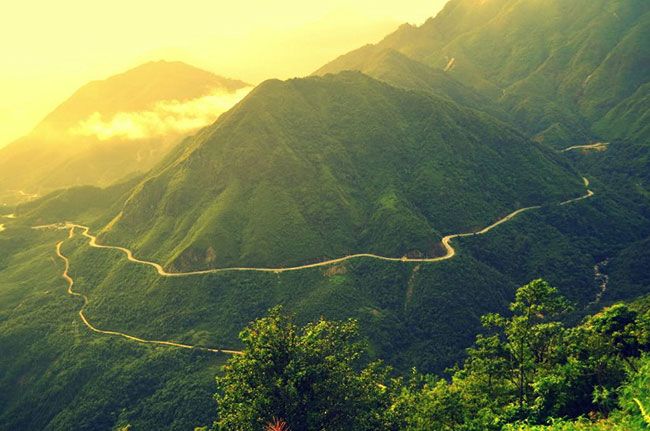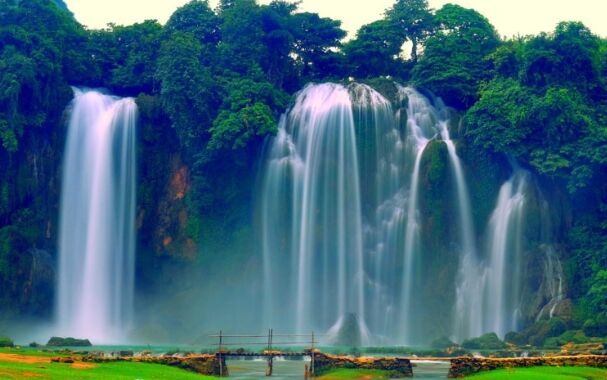
Trekking through the forests in Lai Châu, Vietnam
This summer, go trekking through the forests in Lai Châu, which is blessed by nature with pristine landscapes and a cool climate. Tourists can trek high mountain peaks, explore caves, and visit community villages.
Located 380 km from Hanoi, Lai Châu's allure comes from its untouched natural scenery, floating sea of clouds, and vast rice fields. Besides sightseeing, visitors here also have the opportunity to enjoy the essence of mountain cuisine and immerse themselves in the lives of the Thai, Giay, Hmong, Dao, and other ethnic groups.
Lai Châu has a characteristic Northwestern climate and culture. From January to March, various flowers such as peach blossoms and ban flowers bloom brightly. From April to May, during the water-pouring season, waterfalls roar day and night. From June to August, Lai Châu experiences heavy showers, so tourists need to pack accordingly and arrange their schedules properly. September to October is the time when the rice fields are ripe, painting a bright yellow hue for visitors' photos.
Visit Ô Quy Hồ Pass
Ô Quy Hồ is one of the four great mountain passes in the Northwest region, renowned for its winding road along National Highway 4D, stretching nearly 50 km. In 2015, the pass was recognized as a national scenic spot.

Located at an altitude of 2,350 meters, the climate of the pass is distinctly divided at the area known as Heaven’s Gate. In winter, the Tam Đường side is warm, while the side bordering Sa Pa is cold and foggy all day. Conversely, in summer, the side bordering Sa Pa is cool, while the Tam Đường side is dry and arid. To reach the top of the pass, tourists can book a cable car ticket at the Fansipan station (Sa Pa), then travel from the top of Fansipan to Tram Ton, and continue 4-5 km along National Highway 4D to the destination.
From Heaven’s Gate or the lone tree, visitors can fully enjoy the beauty of Ô Quy Hồ Pass, marvel at the vast sky, endless mountains and forests, and breathe in the fresh air.
Conquer the High Peaks
▸ Bạch Mộc Lương Tử
Bạch Mộc Lương Tử (Kỳ Quang San) lies between two communes: Sin Suối Hồ (Phong Thổ, Lai Châu) and Sàng Ma Sáo (Bát Xát, Lào Cai) with an altitude of 3,046 meters. In terms of difficulty, this mountain ranks third on the list of the most challenging mountains to conquer in Vietnam.

The trekking route to Bạch Mộc Lương Tử is relatively long and features rugged terrain with many cliffs and ridges. From the foot of the mountain to the summit, trekkers will cross numerous streams and dense primeval forests. Upon reaching the summit, an expansive view of mountains, a clear blue sky, and a thick sea of clouds swirling around the mountain peak unfolds before your eyes.
To ensure health and safety, most trekkers opt for a 3-day, 2-night trekking itinerary. If lacking experience, it is advisable to book a tour with reputable organizations so that porters (guides) can assist with carrying luggage and navigating the way up the mountain.
▸ Pu Ta Leng
Pu Ta Leng Mountain (Tam Đường district) stands at an altitude of 3,049 meters, attracting trekkers with its beautiful primeval forests, natural cardamom gardens cultivated by locals, and rhododendron forests that bloom vibrantly every spring.

Conquering Pu Ta Leng, trekkers experience crossing rocky streams, passing through moss-covered forests, navigating through chaotic bamboo groves, and getting enveloped in the mist of the Hoàng Liên Sơn range. Upon reaching the summit, the exhaustion fades away with the sight of white clouds, a peak covered in lush green trees, and clean, dust-free air.
With a difficulty level of 3, the trekking route is quite challenging, requiring stable health and substantial mountain climbing experience. First-time trekkers should join a trekking tour to ensure safety.
Visit Sin Suối Hồ Tourism Village
Sin Suối Hồ village is located at the foot of Son Bac May mountain in Phong Thổ district, about 30 km from Lai Châu city. In 2015, Sin Suối Hồ was recognized as a community tourism village, attracting tourists with its open space and innovative tourism practices. The village offers various homestays and services. Visitors can rent ethnic costumes for photos or hire Hmong guides to learn in detail about the customs and earth-walled house architecture of the village.

On the high slopes, Sin Suối Hồ is adorned with characteristic terraced rice fields. Here, visitors can watch the sun set behind the mountains and appreciate the unique beauty of the remote highlands and also easily rent a homestay to stay overnight or have a BBQ party in the middle of the mountains and forests.

The village also features small market sessions selling mountain specialties and hand-woven brocade items. Additionally, visitors can enjoy a cup of coffee at Sha Coffee, savoring the leisurely pace of life or finding impressive photo spots.
Explore the Pu Sam Cap Cave Complex
Pu Sam Cap is a famous cave complex in Lai Châu, featuring three main caves: Thien Mon, Thien Duong, and Thuy Tinh, along with seven smaller caves. This place holds a mysterious beauty that captivates nature-loving explorers.

Climbing the stone steps from the mountain's foot, the first stop on the Pu Sam Cap journey is Thien Mon Cave. Inside the cave, visitors feel as if they have entered a world of natural art creations. Stalactite columns of various shapes extend from the cave ceiling and rise from the ground.
Next is Thien Duong Cave, likened to a celestial paradise. Near the cave entrance, visitors will encounter a majestic lion-shaped stalactite. Inside the cave is a clear water lake, with a stalactite tower in the middle. The cave walls feature stalactites arranged in layers, resembling terraced fields.
Along with Thien Mon and Thien Duong, there is also Thuy Tinh Cave. However, this cave has not been developed for tourism due to its rugged terrain.
Enjoy Cuisine at San Thàng Night Market
San Thàng Night Market, located in San Thàng commune (Lai Châu city), is held every Saturday night, with the peak hours from 8 to 10 PM. In addition to local agricultural products and goods, the market has many food stalls selling Lai Châu's specialty dishes prepared by ethnic households using natural ingredients.
▸ Sticky Purple Rice
The unique aspect of Lai Châu's sticky purple rice is that it's made from nương glutinous rice grown on terraced fields. Selected grains are plump, uniform, and large, producing fragrant and perfectly sticky rice when cooked. The purple color comes from the khẩu cắm tree—a distinctive forest plant found only in Lai Châu. During cooking, locals mix in shredded coconut, salt, and sugar, and store the rice in bamboo containers to keep it glossy and warm.

Sticky purple rice is often served with grilled fish, smoked buffalo meat, or roasted pork, sometimes paired with can wine or sour star fruit. Visitors can also dip it in sesame salt to balance the savory and sweet flavors.
▸ Nhắng Pho
Before each market session, Giay ethnic families raise free-range black pigs and butcher them to ensure a unique flavor for nhắng pho. The pho noodles are handmade and sliced on-site, and the broth is simmered from pork bones with various Northwestern spices over a wood fire. The chili sauce is also handmade from finely ground chili peppers, soaked for three months in jars, resulting in an irresistibly spicy flavor.
In the chilly weather, enjoying soft pho noodles, a sweet and savory broth combined with the spicy kick of chili, the fragrant basil, and the slightly bitter taste of chayote leaves, makes it hard for visitors to stop eating.
▸ Lam Nhọ
Lam nhọ is a dish rich in Thai ethnic identity, made from thinly sliced buffalo or beef, mixed with makhwen (a type of pepper), chili, garlic, ginger, forest eggplant, pumpkin leaves, and young pumpkin. After marinating, the meat and vegetables are placed in bamboo tubes and grilled until thoroughly cooked. When the meat becomes firm, it is shredded with chopsticks and grilled one last time until tender.

When eaten, lam nhọ is sticky, with tender and sweet meat. For an enhanced flavor, it is best enjoyed with corn wine.
▸ Bánh Dày
In Hmong culture, bánh dày symbolizes the moon and the sun, so its preparation is meticulous. The chosen glutinous rice must be fragrant and sticky. It is soaked for a day and then thoroughly steamed. The steamed rice is then pounded by hand in a mortar until it becomes smooth and cohesive. Finally, it is molded into round cakes on leaves and coated with a layer of bean flour.
Lai Châu bánh dày has no filling and is not seasoned, but when eaten, it has a natural fragrant and sweet taste from the glutinous rice. Diners can enjoy bánh dày with grilled meat or sausage, depending on their preference.